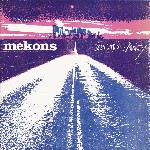|
|
 |
Dusted Reviews
Artist: The Mekons Album: Fear and Whiskey Label: Touch and Go Review date: Apr. 21, 2002 |

|
|
|
 |
John Ford’s classic western, The Searchers, closes with a shot of that tortured giant John Wayne, galloping off into the dry dust and oppressive heat of the American Desert – his image framed by the doorway of a frontier homestead. Everything inside of that door is cool, shadowed, sheltered, and familial, so why, we want to know, why the hell don’t you just come in, Wayne? Kick off the spurs and take a load off? And in a perfect world maybe he could, but in Ford’s world there’s perpetual danger at the doorstep and ghosts on the brain, so John Wayne rides. That’s just what he does – he rides. He can’t do anything about it.
And then, in 1985, a shrewd collective of U.K. punks calling themselves the Mekons happened to run smack into him. At that time in Britain a lot of other folks were wandering hopelessly out-of-doors – on the dole or just homeless in the streets, as Margaret Thatcher followed Reagan’s lead in letting the dollars and pounds trickle down the class pyramid, knowing that they wouldn’t get very far and not caring. In ’85 the Mekons were right there on the front lines of a state-sponsored class war, reunited to play benefit shows for striking miners, and somewhere out there amidst the madness they stumbled upon John Wayne – still riding, still searching, the parched tongue of his by-now delirious horse hanging full-out. “I saw John Wayne ride,” Tom Greenhalgh promises us over a killer riff – what an Ernie Tubbs record might sound like if you sped it up to 45 rpm and poured a whole bottle of J.D. right over the top of it – “darkness and doubt just followed him about.” The question here wasn’t how Wayne had landed himself so far from home – anyone could see, at least the way Greenhalgh sang it over that wobbly, screeching Ernie Tubbs record, that Wayne belonged here. The question was why nobody had ever noticed him here, or other places where he’d quietly been galloping, ever before. Either way, the Mekons got him first – ’85 saw the release of their Fear and Whiskey and country-western became a brand new bullet in the rock’n roll six-shooter.
Now it’s seventeen years later and with Touch and Go’s re-release of this long out-of-print masterpiece people are – for the most part rightfully, I think – again singing its praises. Some folks take it a bit too far. Just for the record, ‘85’s best batch of drinking songs is the Pogues’ great one Rum, Sodomy, and the Lash, and if you want to talk about the pure reinvention of country for sheer power of visceral effect – it’s timeless power of redemption harnessed for a new generation’s aims – you’ll have to wait for the long overdue reissues of Uncle Tupelo’s first three records coming later this year. Both McGowan with Rum, Sodomy, and the Lash and Tweedy/Farrar with No Depression worked their way inside-out from an old form – traditional Irish folk and country, respectively – with a kind of profound clarity. What the Mekons did with country has to do with why alt/country began here, but never sounded even vaguely like this again. Rather than working their way out from its vital center, the Mekons circumscribed its ragged edges so that honky-tonk and hillbilly became new colours on a completely original palette. That was the thing, really – the palette was new. They could start tossing paint around on a dozen different canvases and nobody had time to catch up.
Should we talk about the songs? “Hard to be Human” – a title and lyric ironically boasting the kind of quick-punch crucial to Nancy’s “Just Say No”-style sloganeering – begins with a crunching PiL-esque riff, a wheezing harmonica replaced in the second bridge by a fiery guitar solo doing the exact same job, and features Greenhalgh and Langford trading lines about the ghosts of Cromwell and shouting the song’s title with an acerbic tone that would make a young David Gedge blush. “Flitcraft” kicks off the album’s second side – bizarre, multi-genre, sing-speak, experimental narratives like “Trouble Down South” now replaced by a desperate need to dance and toss a few back before the sun comes up and it’s back to the picket lines – with an embracing of waltz-time and the beautiful fiddling of Suzie Honeyman. “Ya-hoos!” are traded with Dick Dale-style surf riffs, and the boots don’t stop moving for the next five songs – fifteen of the fullest minutes rock or punk has ever seen – through reggae beats, punk licks, and Appalachian fiddling.
“Lost Dance”, the penultimate track before a Hank Williams cover winds down the show, could be the best song the Mekons ever recorded in their twenty-five year career. Honeyman again keeps the ground steady beneath a million moving feet, her fiddle breaking the noise of the sky crashing down with a gorgeously redemptive little lick, with Greenhalgh so overcome with desperation that he breaks into a last-ditch coyote howl and then falls silent to let Honeyman carry them out.
The Mekons saw that in 1985 a lot of people weren’t guaranteed very much. “Here,” they responded. “Here’s that bit of ground you’re standing on, whether you own it or not. Here’s a century’s worth of music. We’ll play, and you can dance.” It’s a bittersweet thing that in a lot of ways, seventeen years later, this record still works on you.
By Nathan Hogan
|







